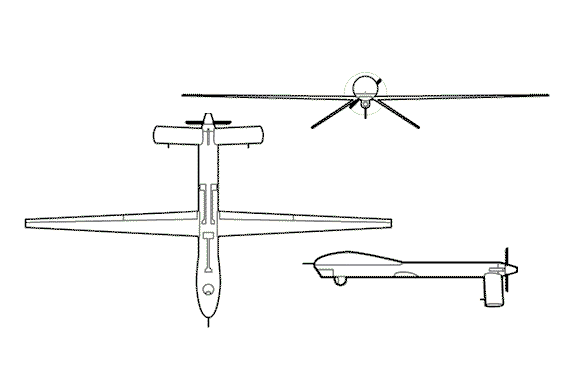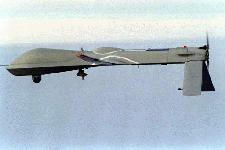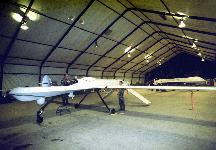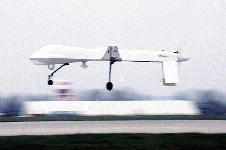




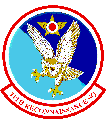
A CIA-controlled Predator firing a Hellfire missile was used to kill six suspected al-Qa'ida terrorists in Yemen on November 3, 2002. This marked the first use of an armed Predator as an attack aircraft outside of a theater of war such as Afghanistan.
According to the Air Force, the Predator is a "Joint Forces Air Commander-owned theater asset for reconnaissance, surveillance and target acquisition in support of the Joint Force commander." Because the Predator is unmanned it is suitable for deployment in "moderate risk areas", unsecured air space, "open ocean environments, and biological or chemical contaminated environments." In addition, as the October 2001 attacks in Afghanistan have illustrated, the Predator can now perform a search and destroy mission with no apparent risk to US military personnel.
The Predator system was designed to provide constant intelligence, surveillance, and reconnaissance to US strategic and tactical forces. This system is operated by the 11th and 15th reconnaissance squadrons at Indian Springs Air Force Auxiliary Field in Nevada.
The Predator Medium Altitude Endurance (MAE) Unmanned Aerial Vehicle (UAV) was developed as an Advanced Concept Technology Demonstration (ACTD) from January 1994 to June 1996. The Predator system is composed of three parts: the air vehicle [a derivative of the Gnat 750] with its associated sensors and communications equipment, the ground control station (GCS), and the product or data dissemination system. One Predator system has four air vehicles with sensors and data links, one Ground Control Station (GCS), and one Trojan Spirit II SATCOM system.
The air vehicle is a mid-wing monoplane with a slender fuselage housing the payload and fuel, a high aspect ratio wing, and inverted-V tails. A four-cylinder Rotax engine that requires 100-octane aviation gas powers the air vehicle. According to the The Air Force Fact Sheet the RQ-1A needs 5,000 by 125 feet of a hard surface runway. In addition, the vehicle requires line-of-sight with the GCS and all support components for the Predator system must be at a single location.
The air vehicle can be broken-down into six primary parts and packed into a container known as the "coffin." The satellite communication system consists of a 20-foot satellite dish and its associated support equipment. This satellite system is especially important because is provides the Predator aerial vehicle to communicate beyond line-of-sight with its GCS. The benefits of this component system are that it can be easily deployed around the world.
The sensors include an electro-optic/infrared (EO/IR) Versatron Skyball Model 18 with a zoom lens and a spotter lens, and a Westinghouse 783R234 synthetic aperture radar (SAR). The ground control station consists of a pilot position and a payload operator position, which are interchangeable, a Data Exploitation, Mission Planning and Communications (DEMPC) position where imagery is annotated and initially exploited, and a SAR workstation. The GCS is housed in a 30 ft x 8 ft x 8 ft commercial van.
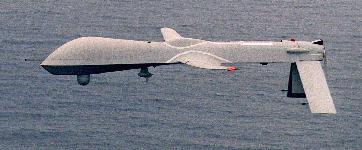 The current data dissemination is through the TROJAN SPIRIT II (TS II), a Special Compartmented Information (SCI) satellite communications (SATCOM) system that allows transmission and receipt of secure voice and National Imagery Transmission Format (NITF) imagery data. The TS II physically consists of two High Mobility Multi-purpose Wheeled Vehicles (HMMWVs) and two trailer-mounted SATCOM antennas. Sensor imagery is disseminated from the Predator ground control station via the Trojan Spirit II SATCOM system using the Joint Deployable Intelligence Support System (JDISS) and the Joint Worldwide Intelligence Communications System (JWICS). Live video is disseminated through the Joint Broadcast System (JBS).
The current data dissemination is through the TROJAN SPIRIT II (TS II), a Special Compartmented Information (SCI) satellite communications (SATCOM) system that allows transmission and receipt of secure voice and National Imagery Transmission Format (NITF) imagery data. The TS II physically consists of two High Mobility Multi-purpose Wheeled Vehicles (HMMWVs) and two trailer-mounted SATCOM antennas. Sensor imagery is disseminated from the Predator ground control station via the Trojan Spirit II SATCOM system using the Joint Deployable Intelligence Support System (JDISS) and the Joint Worldwide Intelligence Communications System (JWICS). Live video is disseminated through the Joint Broadcast System (JBS).
Developed as an Advanced Concept Technology Demonstration (ACTD) program, the Predator has participated in various training exercises, demonstrations, and operational deployments. Three systems were bought as part of the ACTD, totaling twelve air vehicles, three GCSs and three Trojan Spirit IIs. Although the Army initially led the Predator program, the Pentagon chose the Air Force as the lead service.
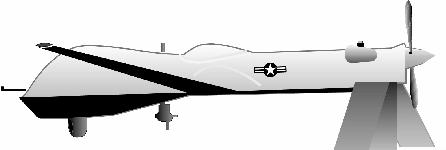
In October of 2001 the Predator was deployed to Afghanistan to provide intelligence and a strike capability to Operation Enduring Freedom.
The Predator system was employed in the 1999 Kosovo air campaign. Predators collected intelligence, searched for targets and kept cameras aimed at Kosovar-Albanian refugees. The aircraft helped planners assess battle damage and sort out the chaos of the battlefield.
During April and May 1995, Predator, as a proof of concept demonstration, participated in Roving Sands 1995, an annual air defense exercise held in the southwestern United States. The success of the Predator during this exercise played a substantial role in the decision to deploy it to the European theater in the summer of 1995.
Predator UAV's have been operational in Bosnia since 1995. Their intelligence gathering capabilities have been exploited by NATO, UN, and US forces in over 600 missions.
The first European deployment, Nomad Vigil, was in support of Joint Task Force Provide Promise (JTF PP) with the Predator based in Gjader, Albania. Tasking was provided by the JTF PP headquarters through the Southern Region Joint Operations Intelligence Center (SR JOIC) in Naples, Italy. The required airspace coordination was performed at the NATO Combined Air Operations Center (CAOC) in Vicenza, Italy. The Predator deployment took place from July through November, 1995. Two aircraft were lost during the EUCOM deployment. It was pulled out after Serb air-defense gunners shot one down and controllers destroyed another in flight because of a malfunction possibly caused by ground fire.
The second European deployment, Nomad Endeavor, was in support of Operation Joint Endeavor with the Predator based in Taszar, Hungary. Tasking was provided by a forward element of U.S. European Command (USEUCOM) through the US National Intelligence Cell (USNIC) at Vicenza, Italy. The operational control of the Predator remained with USEUCOM, but tactical control was exercised by the NATO CAOC. The deployment started in March, 1996.
| Manufacturer: General Atomics |
Runway (ISA): 5000 ft. x 125ft Hard surface |
RATO: no |
Dimensions: length-320.4 in. span-580.8 in. height- 72.0 in. |
| A/Vs in Baseline: 4 |
Data Link: Frequency: C-band Line of Sight: yes Satellite: yes(UHF and Ku) GPS:yes |
Range: Line of Sight on GCS Unlimited via satellite |
Power Plant: Rotax 912 pusher |
| Fuel: type- 110 LL avgas capacity- 110 liters |
Endurance: 24 hours on station at 500NM 40 hours |
Payloads: electro-optical IR (day-night) SAR(all weather) modular |
Operational Altitudes (ISA): to 26,000 ft. MSL |
| Speeds: stall- 54 kts cruise- 70-90 kts dash-120 kts |
Max. Gross Take-off Weight: 2100 lbs |
Weather limits: T/O cross winds-15 kts T/O head winds- 30 kts rain-no visible moisture-limited icing-no turbulence-light |
Auto. Return Home on Data Link Loss: yes |
| Emergency Recovery: parachute |
Relay Flight Capability: in development |
Multiple AV Control: yes: autonomous flight |
Control Transfer to Another Shelter: yes |
